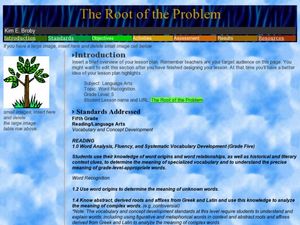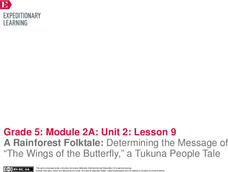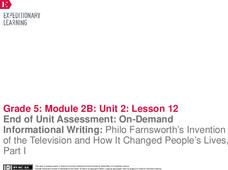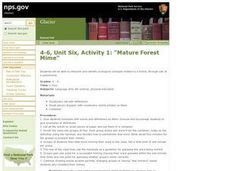Curated OER
The Meaning of Algebraic Expressions
Students define equations and expressions. In this algebra lesson, students review important vocabulary words to do with equations and solving problems. They simplify equations and expressions using addition, subtraction, multiplication...
Curated OER
Using Tiles to Solve Word Problems
Young scholars solve problems using equations. In this algebra instructional activity, students identify the correct symbols and steps when solving word problems. They graph their lines and analyze the slope using tiles.
Curated OER
Math Words with Multiple Meanings
Learners of many ages use the Visual Thesaurus to help them understand the language of math. They work in groups to explore the multiple meanings of common math terms. Pupils come up with examples of the words in mathematical and other...
Curated OER
The Root of the Problem
Identifying root and base words is an important skill. Using this lesson, learners practice identifying Greek and Latin roots. However, this resource is incomplete and should be augmented to provide a complete experience.
Curated OER
Memory Master
Practice spelling words that use prefixes, suffixes, and specific roots. In this grammar lesson plan, learners play a game where they compete with spelling words correctly to gain points. A short set of review questions are also included.
Book Units Teacher
Skill Lessons – Prefixes and Suffixes
Sometimes the best way to understand a concept is to break it down. Young vocabulary pupils work with word parts in a hands-on activity that prompts them to connect flash cards with affixes to their root and base words. Additionally,...
Curated OER
"Shooting an Elephant"
Study selected vocabulary terms in George Orwell's "Shooting an Elephant." A chart includes five selections, and learners must record the connotative and denotative meaning for each. A great look at using the context to define vocabulary...
Achieve3000
Discriminating Phonemes 2
Some sounds sound very similar! Help your class learn how to distinguish between various sounds by following the steps outlined in this plan. The plan includes a warm-up, a teacher-led portion, and details for guided and independent...
EngageNY
Analyzing Images and Language: Inferring about the Natural Disaster in Eight Days
Pictures often reveal different meanings. Scholars analyze the images in Eight Days and discuss how they add meaning to the text. Readers answers questions about how specific colors are used to create different emotions. Learners then...
Curated OER
ASL: Lesson 19
Being able to express feelings is important for every learner. ASL lesson 19 is intended for teaching hearing impaired pupils or special ed teachers functional ASL. Since this provides a list of signs describing feelings, it would be a...
Curated OER
A Nice Story
Explore word choice in writing. Your class listens to a short story entitled "A Nice Day" (included) and discusses how the story could be improved. Pupils replace the word nice throughout the story with various synonyms, then reread the...
EngageNY
Grade 11 ELA Module 2: Unit 1, Lesson 14
Leave the past in the past. Scholars read paragraph 12 of the chapter "Of Our Spiritual Strivings" to analyze Du Bois's development of gaining liberty and leaving the ideas of the past. Pupils then carry out a three to five-minute...
EngageNY
Reading for Gist, Answering Text-Dependent Questions, and Determining Author’s Purpose: Industrial Organic Food Chain
After re-reading The Omnivore’s Dilemma using a Reading Closely: Guiding Questions handout, class members use sticky notes to annotate and determine the gist of the text. Finally, they use an Author’s Purpose graphic organizer to...
EngageNY
Mid-Unit Assessment: Analyzing Visual Elements in a Graphic Novel
Can I get a visual? Scholars work on their mid-unit assessments by analyzing vocabulary and discussing visual elements in Investigating the Scientific Method with Max
Axiom Super Scientist. They then reflect on their learning by...
EngageNY
Research: Paraphrasing Relevant Information
Readers take a look at the source Ethical Style: How Is My T-Shirt Made? and discuss how to say the information in the article without plagiarism. Learners make note of and underline sentences that may present a problem in paraphrasing....
EngageNY
Reading and Writing About How to Perform a Process: How Meg Lowman Studies the Rainforest (Pages 4–8)
It's a process. Scholars read to understand the process Meg Lowman uses for pressing specimens. Learners work in groups to define vocabulary and create a list of the steps used. They then carry out the steps using provided materials.
EngageNY
A Rainforest Folktale: Determining the Message of “The Wings of the Butterfly,” a Tukuna People Tale
Did you the message? Scholars listen to a read aloud of The Wings of the Butterfly to summarize and determine the message of the text. They discuss the folktale and vocabulary in groups, then use a double bubble map to compare the story...
EngageNY
End of Unit Assessment: On-Demand Informational Writing: Philo Farnsworth’s Invention of the Television and How It Changed People’s Lives, Part I
On-demand isn't just for TV anymore. Writers complete their end of the unit assessment with an on-demand writing task. They read the article Television and answer questions about the gist, vocabulary, and content. They then complete a...
Curated OER
My Teacher Can Teach Anyone!
Begin the school year with enthusiasm using the book entitled My Teacher Can Teach Anyone! In this reading for meaning lesson, primary readers listen to the story and discuss what is happening and why the boy in the story might be...
Curated OER
"Swamp Monsters" by Mary Blount Christian
Using the book Swamp Monsters by Mary Blount Christian, young readers discuss key vocabulary terms and make predictions about swamp monsters. They complete a Cloze activity, explore past-tense verbs, and categorize vocabulary words.
Curated OER
Spanish: Body Parts and Beyond
Students drill on Spanish vocabulary words by participating in a card game. They use a list of teacher-prepared clues that are glued to cards. Later they apply these words to skits and dialogues about health issues.
Curated OER
Mature Forest Mime
Young scholars come to understand vocabulary words through pantomime. In this vocabulary lesson plan, students first review several vocabulary words and their meaning, then they work in groups to pantomime the definitions.
Curated OER
Geographically Speaking
Students play a matching game to reinforce the retention of vocabulary words. In this geography lesson, students watch a PowerPoint to define vocabulary words associated with geography, play a memory game with the words, and write an...
Curated OER
Countries of the World
Learners define the meaning of the word country. In this countries of the world map instructional activity, students identify boundaries, countries, and symbols within countries on the map. Learners distinguish the words country and...

























